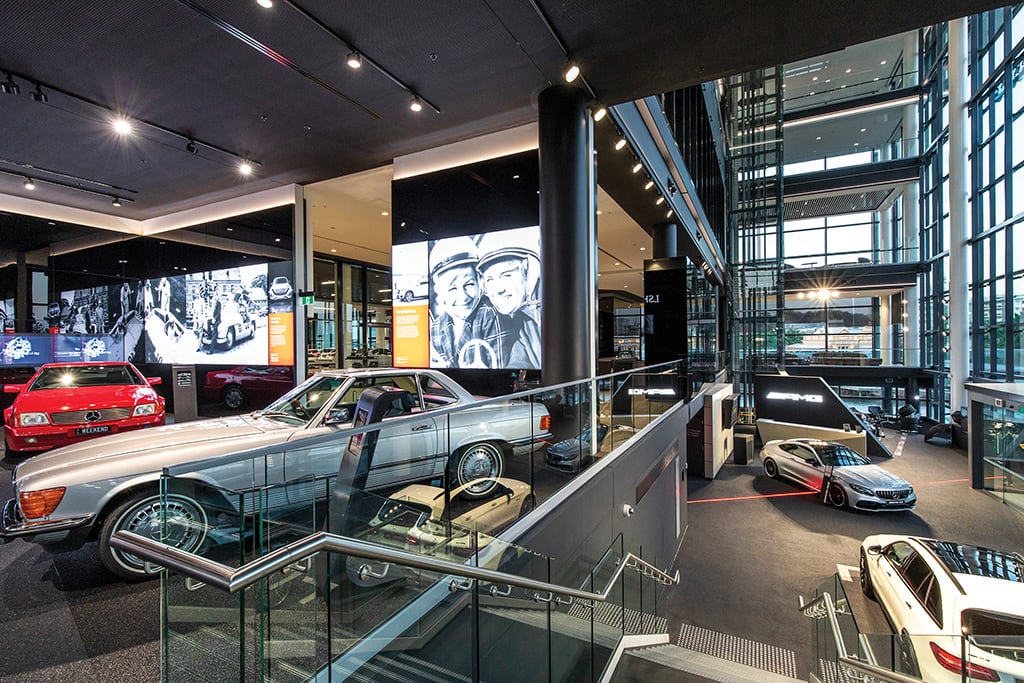
Showroom Showcase
AV is at the heart of the new Mercedes-Benz retail corporate identity. But there were challenges in taking the concept to reality in a one of a kind luxury lifestyle precinct in Brisbane.
Text:/ Derek Powell
Photos:/ Jason Smith Photography
A gleaming new landmark now graces the Brisbane riverfront at Breakfast Creek. Created as a luxury lifestyle precinct, the anchor tenant will be LSH Auto’s state-of-the-art Mercedes-Benz new car showroom and service centre, the first in Australia to incorporate the brand’s new retail corporate identity. Behind the arresting five-storey glass façade is a retail experience like no other – “a prototype for how the world’s leading luxury car brand believes modern premium automotive retail should be experienced”.
Every aspect of the showroom, the design, layout, lighting, furnishings, and the unique audiovisual experience is closely defined in the Mercedes-Benz MAR2020 design rules. This new “market architecture” replaces the previous worldwide Auto Haus theme and is highlighted by what are known as “stage media walls”. These are dramatic 32:9 format video displays, surrounded by floor to ceiling black glass, which form stunning, ever-changing backdrops to the vehicles on display. Faced with such an extensive audiovisual fit-out – and the need to comply closely with the specifications in MAR2020, builder John Holland called upon consultants InDesign Technologies to design and ultimately manage the complex AV installation.
DESIGN RULES OK?
Whilst the MAR2020 provisions were very detailed – much of the description was about outcomes, as this formula was to be applied to different situations and architecture all around the world. Peter Coman, Director of InDesign Technologies takes up the story: “There were 18 volumes of documentation for the whole building. It spoke about the technology and the AV requirements but there were very few specifics.” Indeed, there were no schematics and the only products actually specified by brand were the signage players (which had to be Scala) and special audio components for the AMG showroom – more on that later.
InDesign’s first task then became interpreting the various references throughout the documents to produce a full design specification for approval by Mercedes-Benz, Germany. A major consideration was the technology to be used in the Stage media walls which frame each new car display area. Clearly, direct view LED was a contender with its advantages of variable brightness; but an LCD videowall had a strong claim as well, with a lower capital cost and lesser heat load given the tight confines of the glass structure that housed the display. Ultimately, Peter created designs for both display solutions which were submitted to Germany for approval before a final decision was taken.
“”
There are 18 projectors in the space with a huge amount of curved projection – and that’s the thing that’s very immersive, and impressive

IDEAS AT THE WALL
Meanwhile, Peter was looking carefully at ways to manage the cost of the entire system, which encompassed four floors; multiple videowalls; interactive screens and an audio system. The workflow, as defined in the MAR2020 design rules, envisioned customer interactions where staff using portable tablets could cast specific content to any of the video display walls while chatting with clients. This might relate to model variants, accessories, colour choices and so on. Seamless integration of customer-specific illustrations onto any display was seen by Mercedes-Benz as key to an enriched, 21st century retail experience.
The question for InDesign was how best to enable ad hoc switching from any mobile device to any videowall. Ideally, sales staff should be able to do this from wherever they were, without having to access a touchpanel controller to switch sources.
Early in the development phase a conventional solution was assumed with content sources located in a central rack that were switched then distributed throughout the showroom floors over IP. However, Peter realised that a rethink on this strategy could potentially shave half a million dollars from the burgeoning budget. His distributed strategy placed a Lightware 4×2 mini switcher right at each videowall input. Inputs to the switcher were the Scala players (which provided model-specific branding images in each sales zone) and a Mersive Solstice Pod to which any of the mobile tablets could connect at will. This obviated the need for a centralised rack and video switching system; and a raft of AVoIP or HDBT extenders.
POLL DANCING
Cleverly, the switching could now be automated as Peter explained: “The Crestron central controller polls the switcher at each video wall input every two seconds to check if a mobile device has connected to the local Mersive receiver. With no mobile connection, the videowall will display the brand identity content from the player. Once a salesperson connects to the receiver, the polling detects the new connection and commands the switcher to send the tablet output to the display wall.”
Crucially, the salesperson does not need to access any of the Crestron control screens throughout the building; they simply connect or disconnect using their iPad screen. “The whole idea is we didn’t want touchpanels everywhere,” Peter noted. “We wanted to make it as seamless and as frictionless as possible.”
STAGE MEDIA WALLS
Signage Players: Scala software onLenovo, Thinkstation PC
HDMI Switches: Lightware MMX4x2-HDMI
Monitors: NEC UN551VS
Wireless Presenter: Mersive Solstice POD
Speakers: Yamaha VXS3S & VXS1ML
Amplifiers: Yamaha MA2030A
Videowall Mounts: Chief ConnexSys 55, LVS1U-W
AMG SHOWROOM MEDIA WALL
Speakers: Bose MA-12EX & MB-210 subwoofers
Amplifiers: Bose Powermatch PM4250
BACKGROUND MUSIC SYSTEM
Powered Speakers: Soundtube IPD-CM62-BGM-WH
DSP: Q-SYS Core 500i
Distribution: Dante (each speaker is addressable as a separate zone)

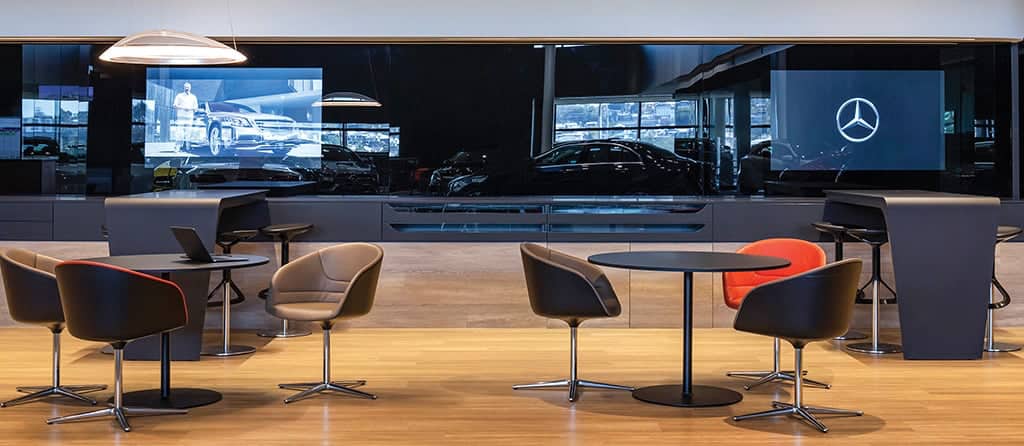
CABIN SOUND
The next question was where to place the speakers that would provide the necessary ambient sound to accompany the video on the screens. There wasn’t a lot of choice. The demanding MAR2020 spec called for floor-to-ceiling black glass with just an 80mm recessed silver kickboard at the bottom and a similar piece at the top. Speakers were not allowed to be visible. Making things more difficult was the fact that many areas didn’t have a ceiling. Fortunately, the Yamaha commercial sound range has a couple of products that could be recessed into the narrow space above the glass. The combination of its baby VXS1ML, with its minuscule 1.5-inch full-range driver and the VX3S 3.5-inch subwoofer, were just the right size to be tucked away.
Interestingly, the showroom devoted to the AMG class vehicles had quite a different look (and specification) from the ultra-smooth feel of the luxury C- and S-class product display areas. Here, the theme is raw and edgy so the videowalls were to be surrounded by a steel mesh and the audio had a lot more punch. The audio for this area was one of the few places where actual products were specified by Mercedes-Benz. Putting some bite into the AMG range video soundtracks were Bose MA-12E speakers together with Bose MB-210 subs.
HITTING THE GO BUTTON
With the design work now basically complete, the construction was progressing apace. Word came back from Germany that either LED or LCD would meet the MAR2020 criteria. Ultimately, the client decided on LCD displays and from that point, the integrator, Corporate Initiatives (CI), moved into top gear. With a six-week installation deadline, things were going to be tight.
Fortunately, InDesign had contacted the major suppliers, such as Crestron, NEC, Lightware and Yamaha and notified them of the project. “They were just waiting for the button to be pushed,” Peter noted. “So within a couple of days, CI had teams of people in there to start installing and getting it all commissioned.”
The most challenging aspect of the build, perhaps not surprisingly, proved to be the stage media walls. The huge black glass sheets framing the videowalls had a clear section that exactly matched the screen size. But the positioning of the monitors behind the glass had to be perfect on all sides. Fitting the huge sheets of glass into position in front of the mounted screens required six strong men using special glazier’s suction pads. However, making everything match proved challenging and the glass needed to be removed and re-fitted several times while tiny, incremental adjustments were made to the alignment of the videowall mounts. “We’re talking millimetres but when you’re not millimetre perfect it shows – you can see any gap,” Peter recalled.
Despite the initial difficulties, Peter rates the project as deeply satisfying. “The whole building just blows you away and the AV compliments that. I’ve always believed that AV shouldn’t be overpowering, it should be complementing what you’re trying to achieve, and I think this project does that really well. The fact that it is actually behind glass means the focus is not on the technology but, as it should be, on the cars.”
TEAM DETAILS
InDesign Technologies:
Peter Coman, Director
Gavin Stein, Documentation
Corporate Initiatives:
Simon Whipps, National Enterprise, Director
Tony Luff, Project Manager
Tyne Ainsley, Installation Lead
Serkan Ozcan, Control System, Programmer
John Holland (Builder):
John Magoffin, Services Manager, Building group
Developer: LHS Property Australia
Andrew Cutter, General Manager Property Development & Operations
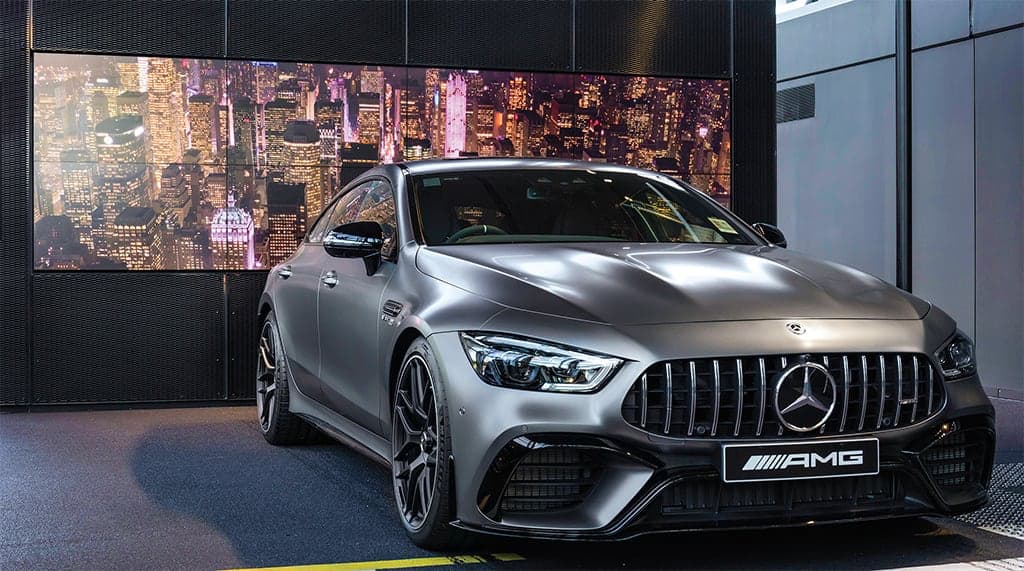





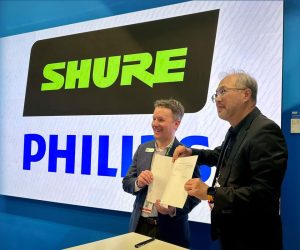
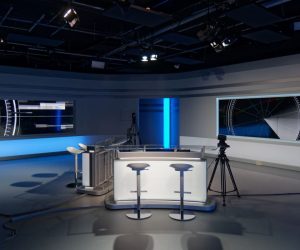
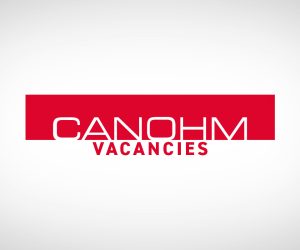

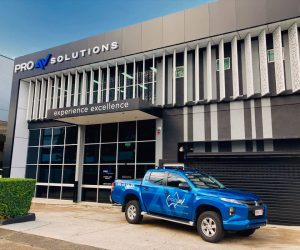





RESPONSES